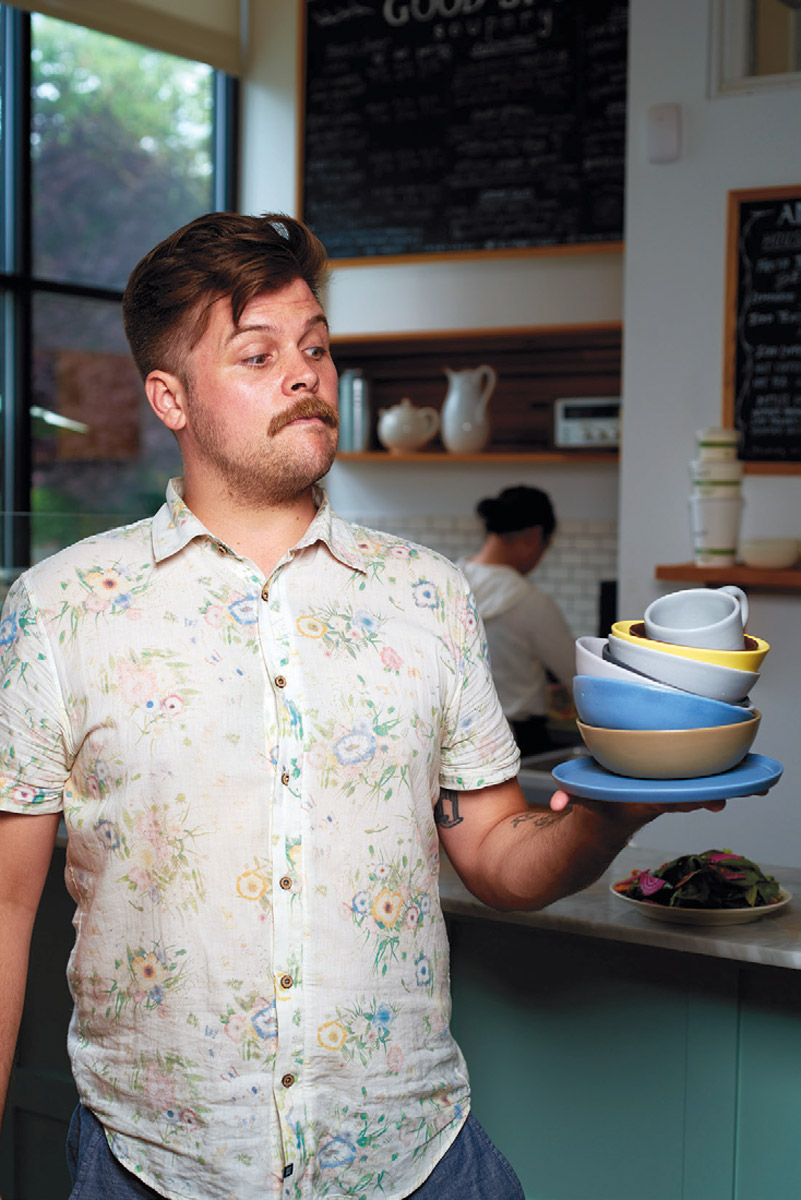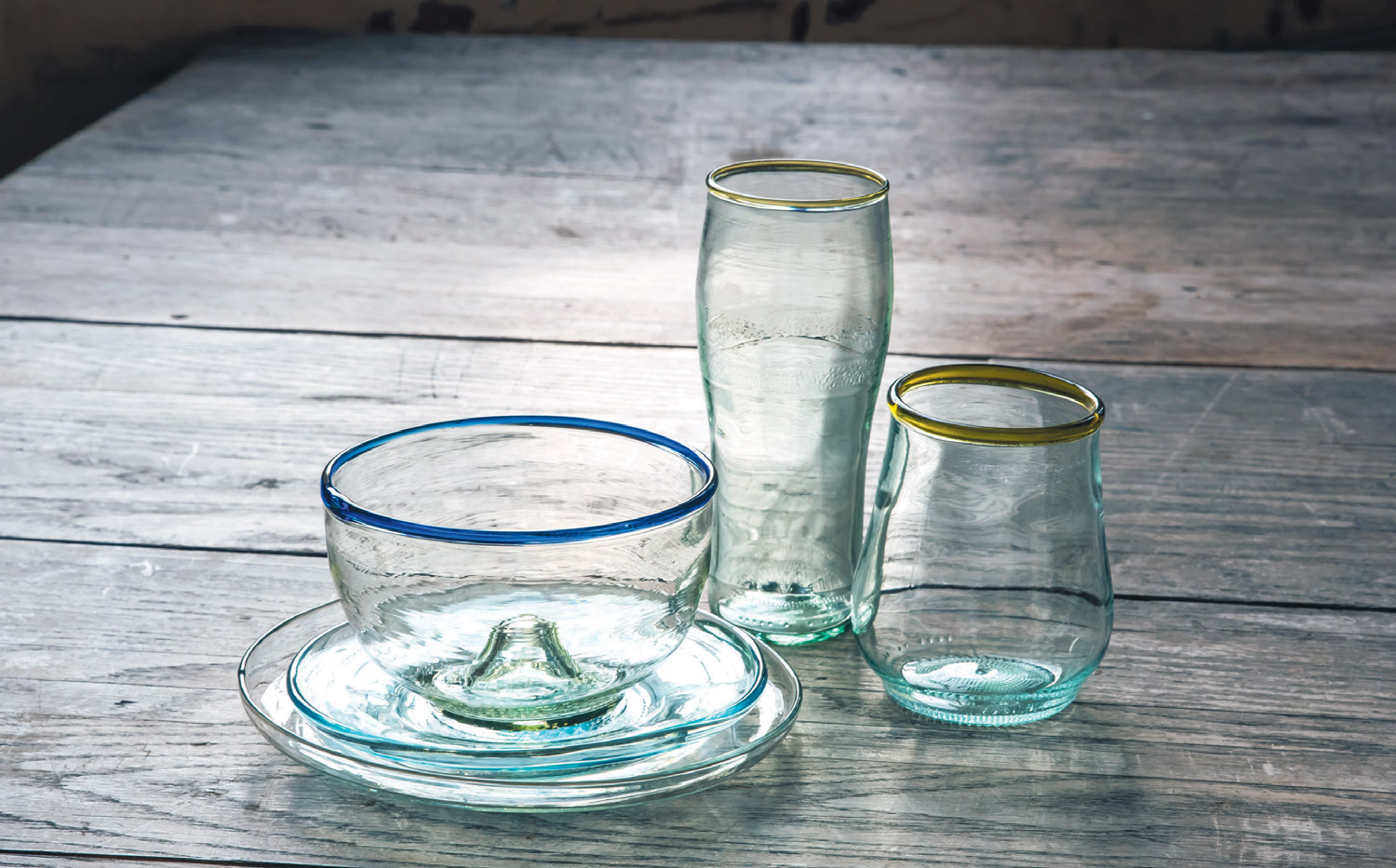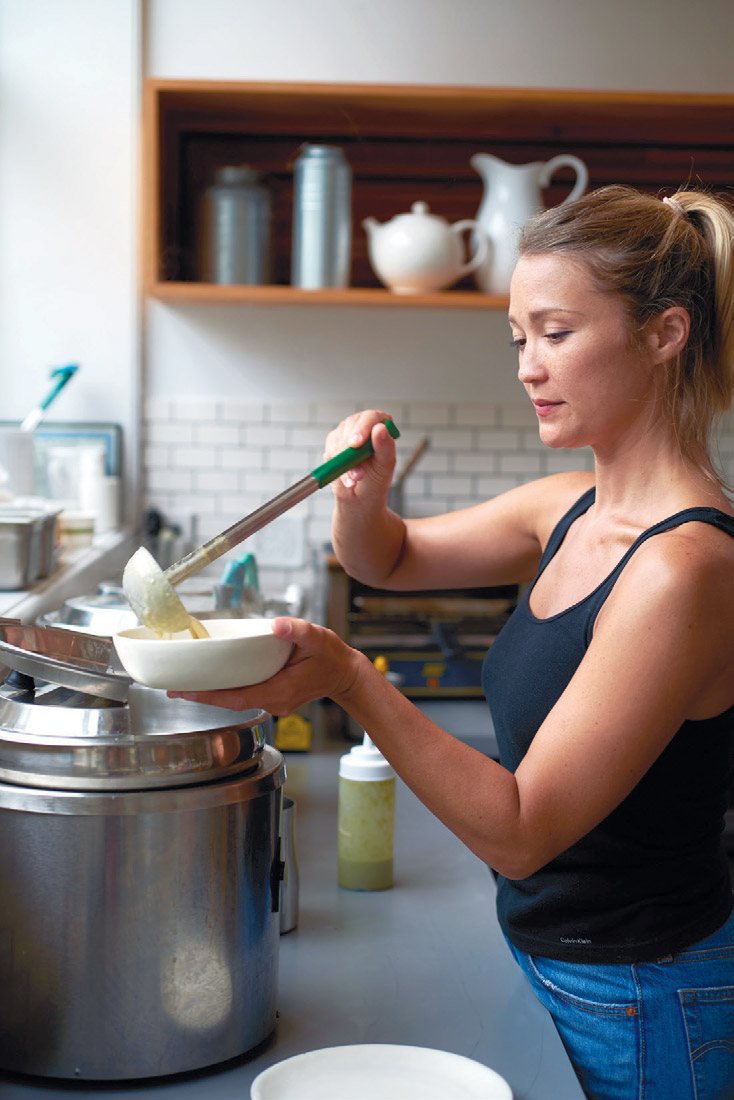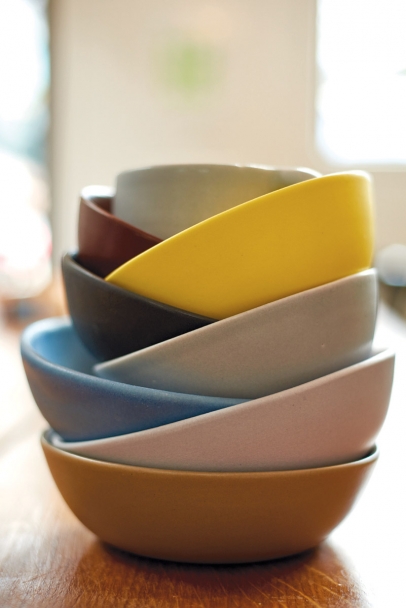Setting the Local Table
Philly artists are doing for our tableware what local farmers have done for our crisper drawers
In a glass-strewn studio in the basement of the Bok Building, a wiry man stood before a 2,000-degree furnace, spinning a long rod attached to the bottom half of a wine bottle.
Underneath the blue elastic sweatband tied around his forehead, his shades reflected the orange glow of the glass as he swiftly pulled it from the heat and took a seat on the bench behind him. Still spinning the rod, he placed a metal cone into the quarter-sized hole and blew into an attached pipe. The molten form inflated to the familiar shape of a stemless wine glass.
Remark Glass—one of the first businesses to set up shop last April in the newly restored Bok Building (formerly Edward W. Bok Technical High School)—salvages used glass bottles and “handcycles” them into striking new dinnerware. Cast-off bottles are given fresh life: what previously held a liter and a half of Woodridge Cabernet becomes an emerald serving bowl; a blue Riesling bottle becomes a delicate drinking glass; a Carlo Rossi jug becomes a clear, wide dinner plate.
“Glass is infinitely recyclable,” Remark co-owner Danielle Ruttenberg says. The artists clean each bottle after it comes in, usually from a local bar like Bok Bar (just a few floors above Remark’s studio) or Tria. The used glass also arrives via friends who bring their own empty bottles. It’s an act of recycling that’s more satisfying than tossing it in the big blue bin. You can even bring in a meaningful bottle—like the champagne bottle from your wedding—and Remark will turn it into a custom piece that you can use every day.
Remark’s pieces are designed for function and beauty; their distinctive character sparks a new level of engagement with a commonplace object.
“It sounds silly talking about something you eat off of every day,” Ruttenberg says. “But you spend so much time with these things you have in your home, you might as well enjoy them more thoroughly.”
These are the type of dishes that create an emotional connection. You’re reminded of each piece’s history and artist when you touch it. These are meaningful art objects that add a level of character to mealtime that you can’t get with mass-produced plates and glasses.
Ruttenberg and her business partners, Rebecca Davies and Mark Ellis, are among a growing community of Philly artists who put the same care and intention into making dishes that our beloved local farmers put into growing food. Their practices often have a sustainable use of resources, thoughtful design, and character that make them distinctively Philly-made.
So when you’re sourcing your quality/locally grown/artisan/ handmade food, consider what it will be eaten from, too. It’s another way to bring richness and personality into your kitchen while supporting our city’s industrious artists.
A slight irregular bulge in a glass makes it interesting; a
chip in porcelain reminds us of the many bowls of soup
it’s held; a spiral divot in the bottom of the mug shows
the finger that once pressed clay to a wheel.

Nate Mell of Felt and Fat
To Make a Dish
To look at a cup from a glassblower’s point of view is to seek to understand its form. How thick is the lip? Is the mouth opening wide or narrow? Does it sit level on the table? Will it contain a 12-ounce beer?
These are the questions Remark considers when designing drinking vessels. When they developed the rocks glass, for example, the artists went through a series of prototypes, measuring and testing them at home.
They settled on a glass that’s 3.5 inches in diameter at the swell near the base, 2.5 inches at the lip and 4 inches tall, with the original ring at the bottom of the bottle kept intact. It’s sturdy (and dishwasher safe) but not too heavy and has a curvature that the hand naturally forms to. (Davies, a former bartender, also made the opening just a tad wider than standard to more easily allow access for a hand equipped with a polishing cloth.)
Even within that one design, there’s variation depending on the bottle used, the maker and the particular day. “It’s not made from a mold, so everything has an individual character,” Ruttenberg explains. They try to stay within a quarter-inch of their ideal dimensions to yield a consistently clean form, and for now, that’s the focus. “We really wanted to start simple, especially going into wholesale,” Ruttenberg says. “We wanted to have a base point and then add on specialty stemware.”
Remark hopes to bring glassware into local restaurants in the coming year. Imagine if Tria served wine in glasses made with the bottles they donated—what a satisfying waste-reducing cycle.
As a longtime maker, Davies appreciates quality tableware at mealtime, especially when she’s at a restaurant of high caliber. “If I go out and I’ve just paid more than I can afford for a really nice steak and it’s served to me on an IKEA plate,” she says, “I’m just kind of insulted.”

Glassware from Remark Glass
“You spend so much time with these
things you have in your home, you might
as well enjoy them more thoroughly.”
At the Table
Though it’s not yet commonplace, locally made tableware has popped up at some Philly restaurants. Much of it is coming from the bright fourth-floor studio in Northeast Philly that houses Felt and Fat, a small team of ceramicists who make porcelain home goods in both simple and spunky designs.
Many of their dishes were designed in collaboration with chefs like Eli Kulp at High Street and Nick Elmi at Laurel. “Our forms developed from a mix of conversations with chefs and experiments in the studio,” cofounder Nate Mell says. They make a range of plates, trays, nesting bowls and mugs in varied sizes that can be finished in matte white, pastel or marbled glazes. Many restaurants prefer the matte white plates. “Chefs like dishes they can get a lot of use out of,” Mell says.
Good Spoon Soupery on North Front Street was one of Felt and Fat’s first restaurant customers. Using locally made dishes goes hand in hand with making soup from scratch with regional ingredients.
“Our philosophy is handmade. That’s how we do everything,” Good Spoon founder Kate Hartman says. “When we were opening the shop at the end of 2014, I knew I wanted the dinnerware to be made by a local ceramicist.”
At the Fishtown café, each portion of soup is served in one of Felt and Fat’s white matte bowls on top of a round plate with a matching finish. The dishes provide a clean background for the colorful soup, and their thickness and slight imperfections give them personality. “They have a rusticness but also a sleek simplicity that I love,” Hartman says.
The dishes Felt and Fat makes for restaurants are often in muted glazes, the primary function being to show off a chef’s creation. But the company makes plates with playful humor and character, too. Scroll through their Instagram feed and you’ll see the many marbled, pastel and funfetti splattered dishes they’ve made.
These are the sorts of dishes the Good Spoon team has at home. “It’s become sort of the go-to gift within the company,” Hartman says. Last year she bought her husband a wide funfetti pasta bowl. “I’m not kidding, for the next two months every single meal he wanted to eat out of that bowl.” Earlier this year, Hartman bought a full set.
Mary Seideman, cofounder of Arcus Medica (a hematology and oncology consulting group), is another local Felt and Fat fan; she’s purchased several sets of dishes after helping to fund the company’s Kickstarter campaign in 2013. She and her husband were looking for dishes for their wedding registry. “We didn’t want china, we didn’t want Pottery Barn,” Seideman says. “We wanted something that was sturdy—we have two boys and we like to entertain—and something that was very organic.”
They chose plates in light and dark gray, large marbled serving dishes and bowls baked with volcanic ash. “Everything is custom,” Seideman says. “You pick the color, the finishes, the size—it’s an incredibly personalized set.” Seideman treasures one particular bowl that’s exactly the right depth and openness for her ramen.
But she recognizes that having a complete set of handmade dishes is a luxury—they’re typically about triple the price of a comparable mass-produced item. If you don’t have the means to stock your entire cabinet, start with items you’ll use every day: a set of small plates or bowls, a coffee mug, a wine glass. You might just find that those handmade dishes get the most use.
Made in Philly
Local ceramicist and teacher Heather Ossandon often trades her work with other artists to fill out her home collection of handmade and vintage objects. “They really are little storytellers,” she says. “They carry with them a narrative, not only about where the material is from but also about the maker.”
Ossandon’s personal work changed two years ago when she moved from Manhattan back to Philly. Though she’s studied ceramics around the world, these days she’s making plates, cups and teapots with sturdy form and aesthetic influenced by Philadelphia.
“These pieces are inspired by the brick around the city,” Ossandon says. “There’s such a history to it—I wanted to take the simplest aspects of that and make it a design.” She uses red brick clay, wax resist and light glazes to play off the architectural patterns in the exposed brick that’s visible in dilapidated buildings (or that acts as accent walls in some apartments). “I build patterns that are focused on negative space, so the raw clay comes through,” she says. One design features a leaved stem reminiscent of ivy climbing up a facade in Old City.
There’s a Japanese concept often applied to ceramics, wabi-sabi, which describes the beauty in imperfection. A slight irregular bulge in a glass makes it interesting; a chip in porcelain reminds us of the many bowls of soup it’s held; a spiral divot in the bottom of the mug shows the finger that once pressed clay to a wheel.
Perhaps this is why we’re attracted to handmade objects. We can feel their history, sense the intention that went into their design and see the evidence of human hands. In the case of tableware, it makes our eating experiences that much richer.
You can purchase directly from the makers mentioned above via their websites.
REMARK GLASS remarkglass.com
FELT AND FAT feltandfat.com
HEATHER OSSANDON heosceramics.com

Supporting local artists fits in with Good Spoon owner
Kate Hartman’s from-scratch, handmade business philosophy.
MAKE IT YOURSELF
Itching to try your hand at the wheel? It’s even more special to have a handmade dish made by you. Design the perfect mug for your morning coffee or make a simple flowerpot for your front stoop, Several Philadelphia studios offer workshops throughout the year to accommodate beginners and more advanced students, too. Visit their websites for updated class schedules.
THE CLAY STUDIO
The well-known hub for local potters hosts frequent Intro to Wheel Throwing courses and Friday night date-night workshops (wine, snacks, friends and flirting opportunities included). Visit the gallery store on the way out to check out work from resident artists. 137-139 N. 2nd St, 215.925.3453, theclaystudio.org
SIX SENSES
The Mount Airy studio offers clay classes for both kids and adults. You can purchase a 10-class card for $250 that can used for any scheduled class. And if you get hooked, Six Senses is home to the Northwest Clay Guild—a group of artists (professional, semi-professional and new to clay) who pay $1,500 a year for unlimited glazes, firing, tools and access to all workshops. 20 E. Mount Airy Ave, 267.650.1757, sixsensesclaystudio.com
UNIVERSITY CITY ARTS LEAGUE
Check the schedule for evening hand-building and wheel-throwing classes as well as after-school beginner pottery classes for kids. Keep your eye out for an upcoming Designing for the Table series to get a start on your handmade collection. 4226 Spruce St, 215.382.7811, ucartsleague.org





